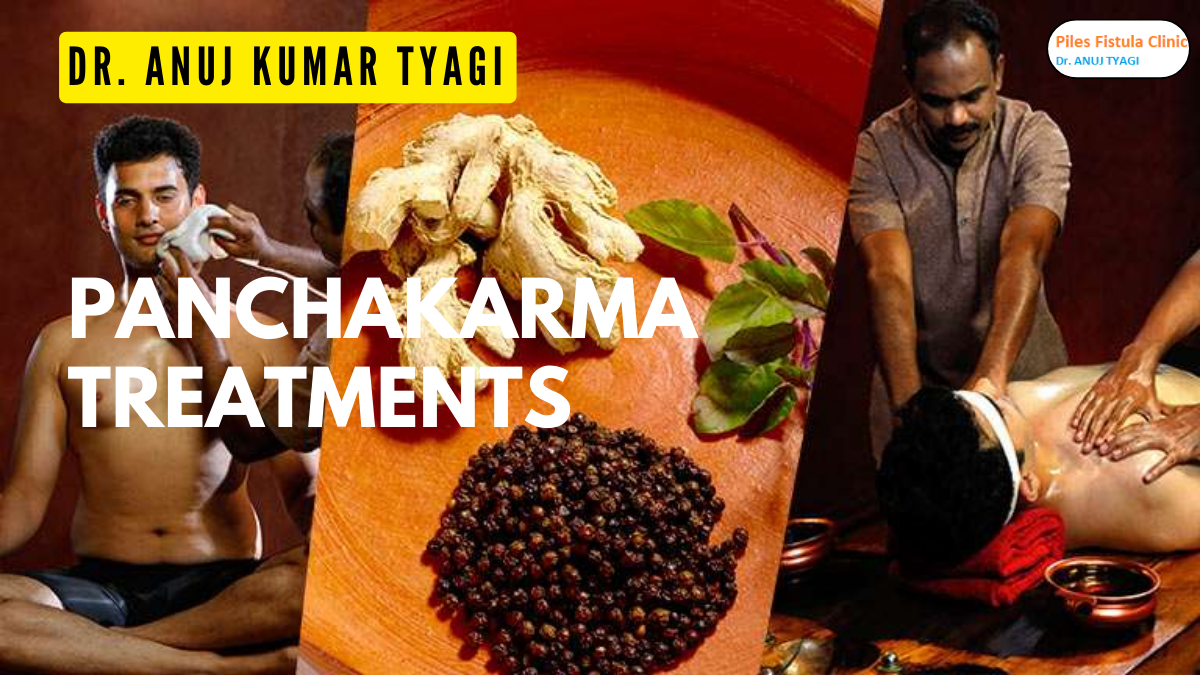
Panchakarma Treatments
A piles fistula clinic signifies knowledge that is pure and precious like gold. Ayurvedic and Panchkarma treatments are available at the Pile Fistula Clinic and Panchkarma Center in Ghaziabad. There is a wide range of treatments offered by our experienced practitioners, including acidity indigestion, PCOS, allergic rhinitis, kidney problems, depression, infertility, fatty liver, and asthma. For a rejuvenating and healing experience, make an appointment with the best Ayurvedic doctor near me.
Ayurvedic medicine describes panchkarma as five methods or five procedures. This program is a traditional rejuvenating detoxification process that detoxifies, strengthens, and restores the balance of the five Doshas, resulting in wellness. Panchkarma is a traditional rejuvenating detoxification procedure. Ayurvedic Panchkarma procedures purify, pacify, and remove the root cause of any disease.
There are two different schools of knowledge in Ayurveda. The first is Sushruta's school, which focuses mostly on surgical procedures since Sushruta was one of the greatest ancient surgeons. The second is Charak's School, which deals with medicine specifically. Both of them have described different illnesses that Panchkarma can treat.
Sushruta Panchkarma includes ....
 Vamana Karma - (Vomitings):- (There, the process of eliminating the imbalances through upward expulsion is called Vaman Karma.) Vaman Karma involves the expulsion of Kapha dosha (imbalance related to phlegm) from the upper part of the body, namely through the oral passage. The timing for Vaman Karma is considered appropriate during the spring season or as directed by a physician, preferably between the 5th and 8th day. Vaman Karma is suitable for conditions such as new fever, cough, breathlessness, sleep disorders, diabetes, tuberculosis, skin diseases (psoriasis, leucoderma, eczema, urticaria, etc.), abdominal diseases, bleeding disorders, glandular swellings, anemia, obesity, madness, epilepsy, and tumors, among other Kapha-related disorders. Just as the destruction of a tree occurs when it is cut, similarly, when Kapha is expelled through Vaman Karma, the diseases arising from it are pacified.
Vamana Karma - (Vomitings):- (There, the process of eliminating the imbalances through upward expulsion is called Vaman Karma.) Vaman Karma involves the expulsion of Kapha dosha (imbalance related to phlegm) from the upper part of the body, namely through the oral passage. The timing for Vaman Karma is considered appropriate during the spring season or as directed by a physician, preferably between the 5th and 8th day. Vaman Karma is suitable for conditions such as new fever, cough, breathlessness, sleep disorders, diabetes, tuberculosis, skin diseases (psoriasis, leucoderma, eczema, urticaria, etc.), abdominal diseases, bleeding disorders, glandular swellings, anemia, obesity, madness, epilepsy, and tumors, among other Kapha-related disorders. Just as the destruction of a tree occurs when it is cut, similarly, when Kapha is expelled through Vaman Karma, the diseases arising from it are pacified.
 Virechana Karma(Purgation) - The process of eliminating imbalances in the lower part is known as Virachana. It involves the expulsion of Pitta dosha (imbalance related to bile) through the anal passage. The recommended time for Virachana is during the autumn or spring season, or as advised by a physician, preferably between the 5th and 9th day. Virachana is suitable for conditions such as fever, skin diseases (leprosy), diabetes, hemorrhoids, fistula, bleeding disorders, jaundice, hepatitis, head diseases, eye diseases, respiratory diseases, madness, heart diseases, epilepsy, gout, swelling, white discharge, glandular diseases, abdominal diseases, and urinary tract disorders.
Virechana Karma(Purgation) - The process of eliminating imbalances in the lower part is known as Virachana. It involves the expulsion of Pitta dosha (imbalance related to bile) through the anal passage. The recommended time for Virachana is during the autumn or spring season, or as advised by a physician, preferably between the 5th and 9th day. Virachana is suitable for conditions such as fever, skin diseases (leprosy), diabetes, hemorrhoids, fistula, bleeding disorders, jaundice, hepatitis, head diseases, eye diseases, respiratory diseases, madness, heart diseases, epilepsy, gout, swelling, white discharge, glandular diseases, abdominal diseases, and urinary tract disorders.
 Vasti Karma: The action of administering medicines (decoctions, oils, ghee, milk, blood, and meat extracts) used for the treatment of Vata dosha through the rectal route to reach the colon is called Vasti Karma. This is because the root location of Vata is the colon. There are two types of Vasti: Anuv?sana Vasti and Niruha Vasti. Vasti Karma has various methods, including a mention of Uttara Vasti. Uttara Vasti is performed through the urinary passage and the vaginal route for disorders related to the uterus and urinary system. Vasti is suitable for conditions such as Vata disorders, abdominal diseases, systemic Vata, fistula, mental disorders, women's disorders, reproductive issues, urinary disorders, worm infestations, heart pain, insanity, headache, side pain, back pain, arthritis, paralysis, obesity, old age-related issues, and various Vata-related diseases.
Vasti Karma: The action of administering medicines (decoctions, oils, ghee, milk, blood, and meat extracts) used for the treatment of Vata dosha through the rectal route to reach the colon is called Vasti Karma. This is because the root location of Vata is the colon. There are two types of Vasti: Anuv?sana Vasti and Niruha Vasti. Vasti Karma has various methods, including a mention of Uttara Vasti. Uttara Vasti is performed through the urinary passage and the vaginal route for disorders related to the uterus and urinary system. Vasti is suitable for conditions such as Vata disorders, abdominal diseases, systemic Vata, fistula, mental disorders, women's disorders, reproductive issues, urinary disorders, worm infestations, heart pain, insanity, headache, side pain, back pain, arthritis, paralysis, obesity, old age-related issues, and various Vata-related diseases.
Nasya Karma: The administration of medicinal substances, whether in the form of liquids, powders, or liquids, through the nostrils to expel Kapha dosha is known as Nasya Karma. The nose is considered the best organ of the human body, and the nostrils are referred to as the gateway to the head. Nasya is suitable for conditions such as head diseases, headaches, paralysis, nasal congestion, sneezing, eye diseases, mouth disorders, dental issues, stiffness of the neck, voice disorders, ear diseases, and other Kapha-related disorders. Nasya is performed after Vaman Karma (emesis therapy) for the expulsion of Kapha dosha. The recommended time for Nasya is during the spring season or as directed by a physician, preferably for a duration of 7 to 21 days.
Raktamokshana: The activity of removing impure blood from the body is called Raktamokshana. There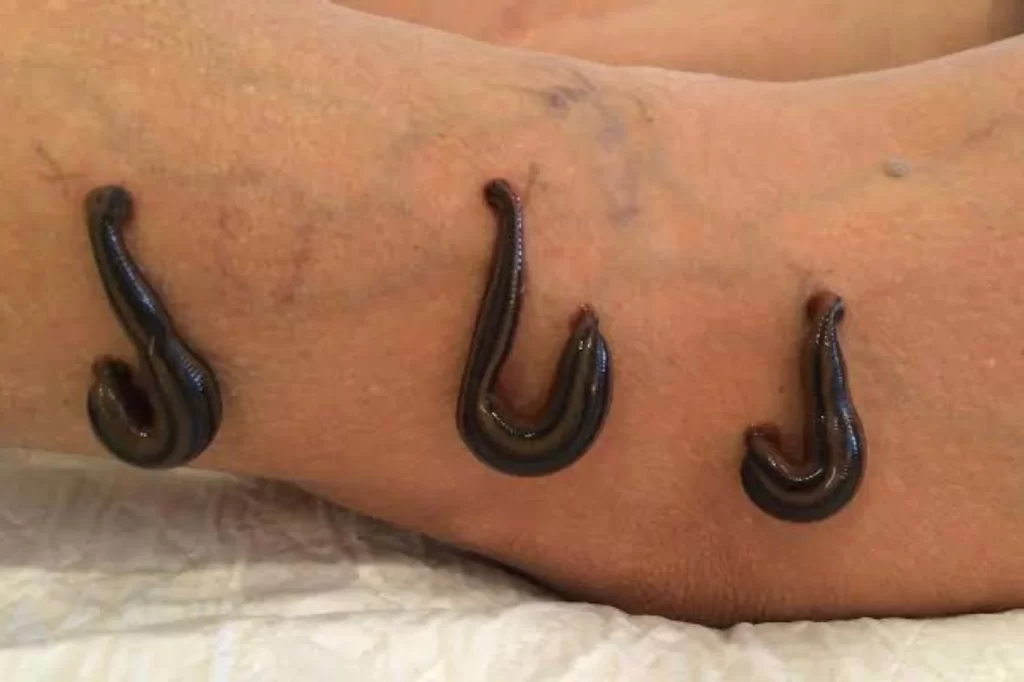 are two types: Jalauka Vacharana (leech therapy) and Shiravedha (venesection). Raktamokshana is suitable for conditions such as skin diseases (psoriasis, leucoderma, alopecia, gout), Vatarakta (gout), hemorrhoids, and other related disorders. The timing is weekly, as per the guidance of the physician.
are two types: Jalauka Vacharana (leech therapy) and Shiravedha (venesection). Raktamokshana is suitable for conditions such as skin diseases (psoriasis, leucoderma, alopecia, gout), Vatarakta (gout), hemorrhoids, and other related disorders. The timing is weekly, as per the guidance of the physician.
The above-mentioned five procedures are performed for body purification. Additionally, there are various other therapeutic measures used for the treatment of specific diseases that arise. Therefore, they are collectively referred to as practical Panchakarma.

Netra Tarpana: In this procedure, the entire eye is surrounded from all sides, and a reservoir is created. Medicinal substances such as Siddha Ghrita (medicated ghee), Kwatha (herbal decoction), Swaras (juice), etc., are poured into it. The eyes are then opened and closed during the process.
Netra Tarpana is suitable for conditions such as eye discharge, visual disorders, eye pain, and burning sensations. The duration is typically 30 minutes daily, with a schedule of one day on, two days off, two days on, and so on, for a total of 21 days.
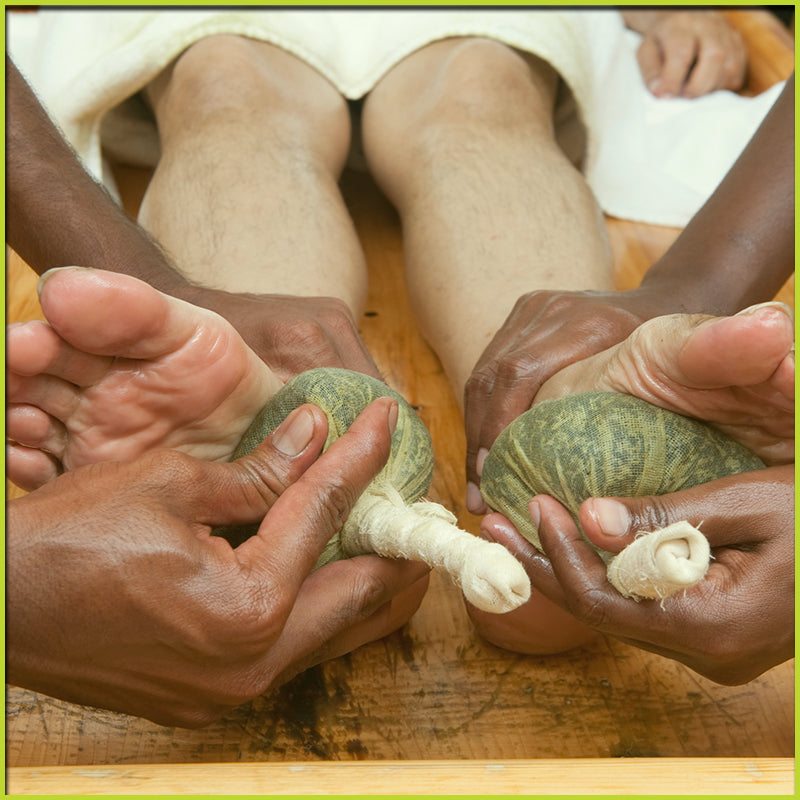 Patrapinda Swedana: In this method, medicinal leaves and powders are cooked, and a poultice is made by tying them in a cloth. This poultice is then heated in medicated oil and applied to the affected area. This process is called Patrapinda Swedana.
Patrapinda Swedana: In this method, medicinal leaves and powders are cooked, and a poultice is made by tying them in a cloth. This poultice is then heated in medicated oil and applied to the affected area. This process is called Patrapinda Swedana.
Patrapinda Swedana is suitable for conditions such as lower back pain (lumbar pain), spondylosis, cervical spondylosis, and arthritis, among others. The duration of the treatment is typically 8 days, 16 days, or 30 days, with each session lasting from 1 to 1.5 hours daily.
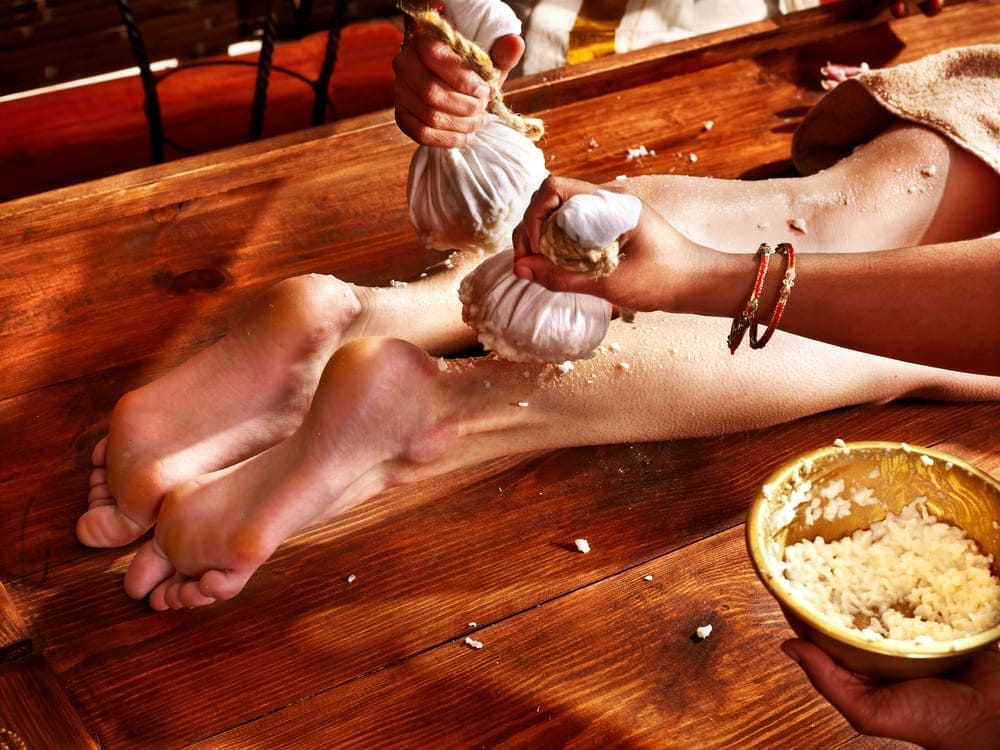 Shashtika Shali Pinda Swedana: In this method, rice (Shali) is cooked in cow's milk and herbal decoctions (Kwatha). The cooked rice is then tied in a cloth to make a poultice, which is immersed in the herbal decoction and used to apply friction to the entire body. This process is called Shashtika Shali Pinda Swedana.
Shashtika Shali Pinda Swedana: In this method, rice (Shali) is cooked in cow's milk and herbal decoctions (Kwatha). The cooked rice is then tied in a cloth to make a poultice, which is immersed in the herbal decoction and used to apply friction to the entire body. This process is called Shashtika Shali Pinda Swedana.
Shashtika Shali Pinda Swedana is suitable for conditions such as muscular wasting, muscle degeneration, and conditions like Muscular Dystrophy and Pliomyelitis. The duration of the treatment is typically 8 days, 16 days, or 30 days, with each session lasting from 1 to 1.5 hours daily.
 Pinda Sweda: Pinda Sweda is a therapeutic Ayurvedic treatment involving the application of hot poultices filled with medicinal herbs and rice to specific areas of the body. This practice aims to alleviate pain, reduce inflammation, and promote relaxation.
Pinda Sweda: Pinda Sweda is a therapeutic Ayurvedic treatment involving the application of hot poultices filled with medicinal herbs and rice to specific areas of the body. This practice aims to alleviate pain, reduce inflammation, and promote relaxation.
Book appointment with Dr. Anuj Tyagi to get relief from various ailments affecting your life. You can consult him for Pinda Sweda as he is engaged in the practice and propagation of Ayurveda for years now.
The is registered with authorities and offers affordable Ayurvedic treatment to the residents of Ghaziabad.
 Abhayangam: Avagaham is a method of sweating for which the patient is seated in a tub full of hot herbal decoction. According to the condition of the disease suitable medicated oil can be applied on the body prior to this. The aim of this treatment is to sweat the body and there by making the vata moving in its own root. It is a method of preparation for the cleansing treatment or the panchakarma. The oil application and the thorough sweating of the body help for the expulsion of the toxins from their bonded sites very easily. Because of the sweating it gives relief for the pain and stiffness of the joints and the back. Book appointment with Dr.Anuj Tyagi to get relief from various ailments affecting your life. You can consult him for Abhyanga as he is engaged in the practice and propagation of Ayurveda for years now. The is registered with authorities and offers affordable Ayurvedic treatment to the residents of Ghaziabad.
Abhayangam: Avagaham is a method of sweating for which the patient is seated in a tub full of hot herbal decoction. According to the condition of the disease suitable medicated oil can be applied on the body prior to this. The aim of this treatment is to sweat the body and there by making the vata moving in its own root. It is a method of preparation for the cleansing treatment or the panchakarma. The oil application and the thorough sweating of the body help for the expulsion of the toxins from their bonded sites very easily. Because of the sweating it gives relief for the pain and stiffness of the joints and the back. Book appointment with Dr.Anuj Tyagi to get relief from various ailments affecting your life. You can consult him for Abhyanga as he is engaged in the practice and propagation of Ayurveda for years now. The is registered with authorities and offers affordable Ayurvedic treatment to the residents of Ghaziabad.
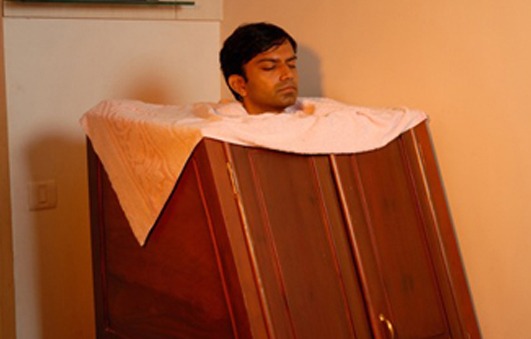 Swedana: The process by which sweat is expelled from the body, leading to the relaxation of muscles, relief from heaviness, and elimination of stiffness in the body. This is referred to as perspiration.
Swedana: The process by which sweat is expelled from the body, leading to the relaxation of muscles, relief from heaviness, and elimination of stiffness in the body. This is referred to as perspiration.
Beyond its thermoregulatory function, sweating plays a crucial role in detoxification by expelling certain waste products and toxins from the body through the pores. This cleansing process contributes to the overall well-being and health of an individual.
 Kati Vasti: In this procedure, a circular enclosure is formed around the lower back (lumbar region), and warm medicinal oil is gently poured into it. The oil is maintained at a consistent temperature throughout the process. This method is particularly beneficial for addressing lumbar issues such as lumbar spondylosis. The recommended duration for this therapy is 30-40 minutes per day, conducted daily for a period ranging from 8 to 16 days. This practice aims to provide relief and support for individuals experiencing lumbar-related discomfort and conditions.
Kati Vasti: In this procedure, a circular enclosure is formed around the lower back (lumbar region), and warm medicinal oil is gently poured into it. The oil is maintained at a consistent temperature throughout the process. This method is particularly beneficial for addressing lumbar issues such as lumbar spondylosis. The recommended duration for this therapy is 30-40 minutes per day, conducted daily for a period ranging from 8 to 16 days. This practice aims to provide relief and support for individuals experiencing lumbar-related discomfort and conditions.
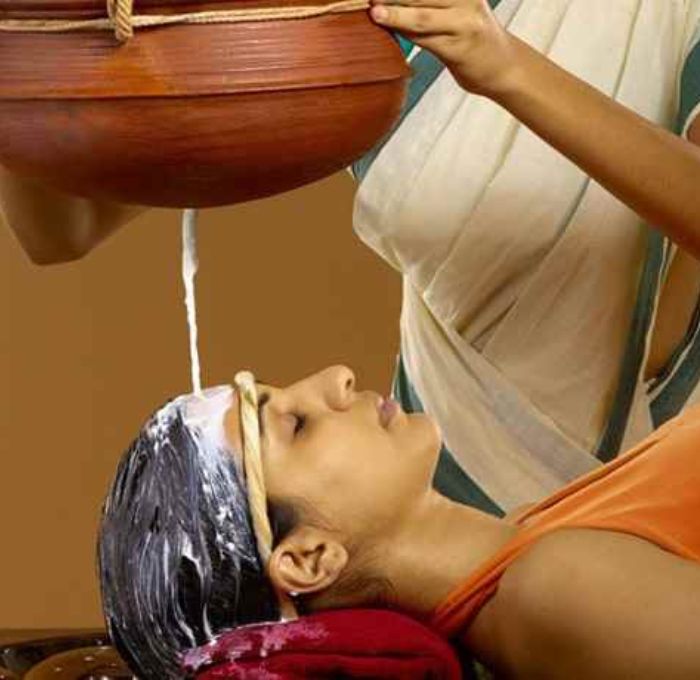 Dugdhadhara: Dugdhadhara, also known as the continuous pouring of warm milk over the entire body, is a therapeutic procedure aimed at promoting various health benefits. This traditional practice is suitable for enhancing skin health by addressing dryness and promoting a radiant complexion.
Dugdhadhara: Dugdhadhara, also known as the continuous pouring of warm milk over the entire body, is a therapeutic procedure aimed at promoting various health benefits. This traditional practice is suitable for enhancing skin health by addressing dryness and promoting a radiant complexion.
In this process, a continuous stream of warm (lukewarm) milk is poured over the entire body. Suitable for: Enhancing skin health, alleviating dryness, promoting muscle development, addressing weakness, and improving skin radiance. Duration: 8 days, 16 sessions daily, 40 minutes each.
 Valuka Sweda: Valuka Sweda, also known as Sand Fomentation, is a therapeutic procedure in Ayurveda. In this process, medicinal powder is mixed with sand to make a poultice, and this poultice is heated on the sand and then used for fomentation (sweating) on the entire body. Valuka Sweda is often recommended for conditions such as rheumatoid arthritis, sciatica, and edema. Suitable for: The duration of this treatment typically ranges from 8 to 16 days, providing relief and promoting overall well-being.
Valuka Sweda: Valuka Sweda, also known as Sand Fomentation, is a therapeutic procedure in Ayurveda. In this process, medicinal powder is mixed with sand to make a poultice, and this poultice is heated on the sand and then used for fomentation (sweating) on the entire body. Valuka Sweda is often recommended for conditions such as rheumatoid arthritis, sciatica, and edema. Suitable for: The duration of this treatment typically ranges from 8 to 16 days, providing relief and promoting overall well-being.
Janu Basti: Janu Basti is a therapeutic procedure in Ayurveda aimed at addressing knee-related issues, particularly Osteoarthritis. The oil is carefully selected based on its therapeutic properties to alleviate pain and promote joint health. The method involves creating a well using a dough boundary around the knee joint and then filling it with medicated oil. In this procedure, a ring is created around the knee, and medicated oil is poured into it, maintaining a consistent temperature. Suitable for: Knee pain (Osteoarthritis). Duration: 30-40 minutes daily for 8 to 16 days.
Greeva Vasti (Greeva Basti): "Greeva Vasti" is an Ayurvedic therapy that involves creating a circular barrier around the neck and filling it with medicated oil. This is done to regulate the temperature and is often recommended for conditions like Cervical Spondylosis. In this procedure, a circular barrier is formed around the neck, and therapeutic oil is poured into it to control its temperature. This practice is particularly recommended for managing Cervical Spondylosis. The recommended duration for each session is 30-40 minutes, to be performed daily for a period of 8 to 16 days.
 Kashaya Vasti: Kashaya Vasti involves applying heat to specific parts of the body by retaining warm medicated oils. An herbal dough dam is built on the affected area, poured with oil, and left to rest. The result is that it helps rejuvenate your body by relieving pain, tension, and swelling. Using this Ayurvedic therapy, you can get rid of chronic and acute back pain, prolapsed discs, lumbar spondylitis, sciatica, and osteoporosis. There are many benefits to Kashaya Vasti, including reducing pain in inter-vertebral disc prolapse (IVDP), stimulating nerves for relief of pain and numbness, and relieving rheumatoid arthritis, disc bulge, and lumbosacral strain.
Kashaya Vasti: Kashaya Vasti involves applying heat to specific parts of the body by retaining warm medicated oils. An herbal dough dam is built on the affected area, poured with oil, and left to rest. The result is that it helps rejuvenate your body by relieving pain, tension, and swelling. Using this Ayurvedic therapy, you can get rid of chronic and acute back pain, prolapsed discs, lumbar spondylitis, sciatica, and osteoporosis. There are many benefits to Kashaya Vasti, including reducing pain in inter-vertebral disc prolapse (IVDP), stimulating nerves for relief of pain and numbness, and relieving rheumatoid arthritis, disc bulge, and lumbosacral strain.
Dhoomapana: Dhoomapan is a therapeutic procedure involving the preparation of a medicinal powder tablet, which is ignited, and the resulting smoke is inhaled through the nostrils, with exhalation occurring through the mouth. In this process, a medicinal powder is made into a tablet, which is then lit, and the smoke is inhaled by pulling it through the nose and exhaling through the mouth. It is suitable for diseases related to phlegm, oral disorders, throat disorders, head disorders, eye disorders, ear disorders, and is performed after emesis therapy. Time: 15 minutes after nasal administration.
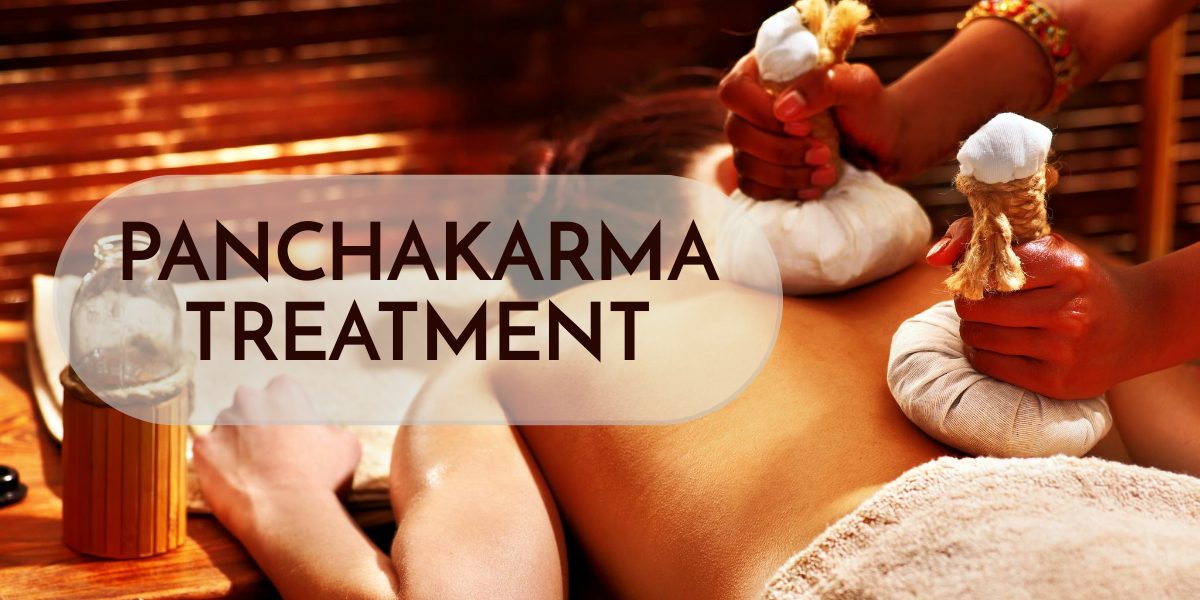
The goal of panchkarma is to eliminate toxins and remove deep-rooted impurities from the body while balancing the Doshas, which are the forces that regulate all biological functions. Ayurveda describes Panchkarma as a miraculous treatment for a variety of ailments.
Click here for detailed information related to Panchakarma treatment
